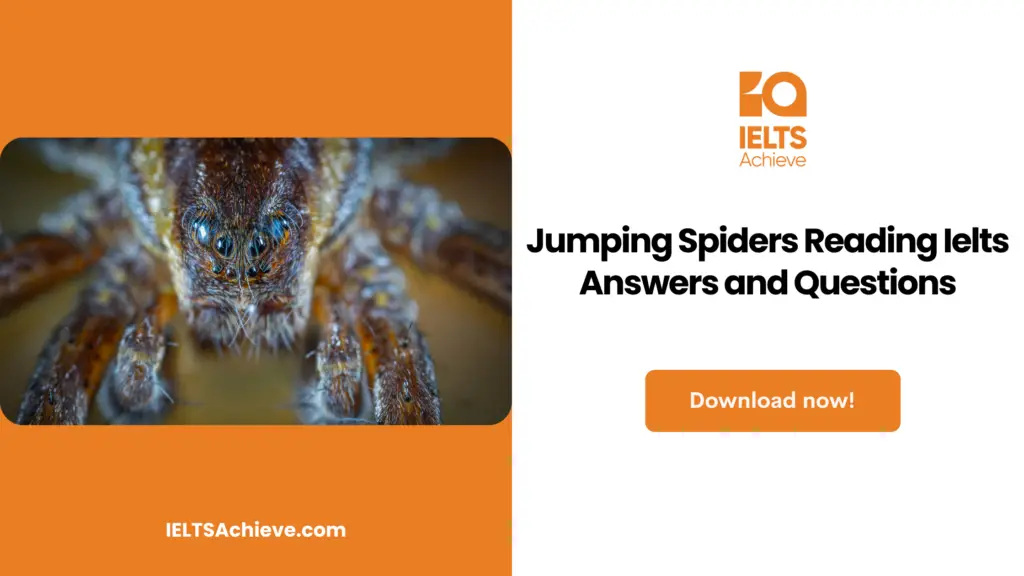The Blog post contains the following IELTS Reading Questions:
- IELTS Reading Multiple Choice Questions
- IELTS Reading Note Completion
- IELTS Reading Locating Information
Stay informed and prepared for success – Explore our comprehensive Reading Test Info page to get valuable insights, exam format details, and expert tips for mastering the IELTS Reading section.
IELTS Reading Passage – Jumping spiders

Jumping spiders – Peter Aldhons examines how Portia spiders catch their prey
The element of surprise is critical for a stalking predator. And for jumping spiders who slip into the sites of other spiders to feast on their owners, it might be the difference between having food and becoming one. Now, zoologists have found the spiders’ secret strategy: creeping forward while the web of their prey is vibrating.
The adults of the fifteen known species of Portia jumping spiders are roughly two millimetres long, which is shorter than the majority of pen caps. They often reside in the webs of other spiders, and the most inconspicuous portion of these webs. The majority of Portia spiders inhabit tropical woods, where the temperature is hot and humid. They chase a variety of different spiders, some of which are more than capable of turning the tables on them. Stimson Wilcox of Binghamton University in the state of New York said, “They will attack anything about twice their size if they are particularly hungry.” Wilcox and his colleague Kristen Gentile of the University of Canterbury in Christchurch, New Zealand, sought to determine how Portia spiders maintain their advantage.
All jumping spiders have huge eyes that resemble binocular lenses, and these eyes operate similarly. Many jumping spiders detect their prey optically, then leap from one to over 10 centimetres away to grab it. The Portia spider is one of the rare kinds of jumping spiders that infiltrate the webs of other spider species. The Portia spider and other jumping spiders hunt insects and other arthropods through stalking. Occasionally, spiders entice their prey by vibrating their webs to simulate an insect’s fight. However, many spiders that spin webs seem to be aware of these strategies, therefore stalking is often a more effective tactic. The researchers discovered that Portia spiders sometimes exploit the web vibrations caused by a little wind. If required, though, they will generate their own vibrations.
The researchers let a variety of prey spiders to weave webs in the laboratory before introducing Portia spiders. To imitate the shaking impact of the wind, the zoologists used either a miniature aircraft propeller or a small magnet affixed to the centre of the web that could be vibrated by supplying a variable electrical field. The researchers observed that the stalking Portia spiders moved more while the webs were swaying than when they were still, and that they were more likely to catch prey during experiments in which the webs were intermittently swayed than in those in which the webs were still. If spiders were put on uninhabited webs, they would not alter their motions.
Researchers are especially interested in the Portia spider’s strategy of causing its prey’s webs to tremble. They observed that spiders would sometimes aggressively disrupt their predator’s net, then crawl up to five millimetres before the vibrations subsided. Wilcox states, “They would create a loud thump through one of their rear legs”. The researchers were originally shocked that the prey spiders did not react to these far more strong vibrations than those produced by Portia spiders to stimulate a trapped bug. Since then, however, they have found that the severe twanging generates a sequence of vibrations identical to those produced by a branch falling onto a net.
Other predators utilise natural ‘smokescreens’ or disguise to conceal themselves from their prey; for instance, lions hunting at night, approach their prey when clouds cover the moon. Wilcox states that this is the first instance of an animal creating a smokescreen that we are aware of. ‘Portia spiders are demonstrably clever, and they frequently acquire from their victim while attempting to trap it. They accomplish it by leaving a variety of signals on the web of their target till the prey spider makes a move.
In principle, Portia spiders modify their stalking approach based on what their victim is doing and how it is behaving. Thus, Portia spiders acquire stalking skills by experimenting and failing. Periodically, they may even follow a circuitous approach to catch a prey spider they have spotted from a distance. Following a predefined itinerary, this might sometimes take up to two hours. When it does this, the Portia spider is really resolving issues and planning its next move.
Unlock your full potential in the IELTS Reading section – Visit our IELTS Reading Practice Question Answer page now!
Recommended Questions:
Renewable Energy IELTS Reading Question with Answer
Jumping Spiders IELTS Reading Questions
Questions 1-4
Select the appropriate letter, A, B, C, or D, and write it on your answer sheet.
1. In experimental trials, researchers discovered that Portia spiders were most active when their web was
- motionless.
- unoccupied.
- vibrating.
- Undisturbed.
2. What discovery did scientists make about Portia spiders?
- They move slowly when vibrations stop.
- They move 5 mm at a time on a still web.
- They use energetic vibrations to mimic a trapped insect.
- They make very strong vibrations with one leg.
3. Portia spiders were the only recognized animal to
- create their smokescreen.
- use the weather to disguise themselves.
- stalk using ‘trial and error’.
- mimic other prey-eating animals.
4. The Portia spider demonstrates ‘thinking ahead’ when it
- reaches its prey in a short time.
- chooses prey that is a short distance away.
- solves the problem of locating its prey.
- takes a longer route to reach its prey.
Ready to improve your performance in Multiple Choice Questions (MCQs)? Click here to access our comprehensive guide on how to tackle MCQs effectively in the IELTS Reading section.
Questions 5-7
Complete the notes. Write NO MORE THAN TWO WORDS from the passage for each answer.
5. The zoologists used either a small aeroplane propeller or a small magnet to simulate the ________ of the wind.
6. They do this by leaving a variety of _______ on the web of their victim spider until it moves.
7. Portia spiders learn stalking abilities by _______ and error.
Boost your performance in Summary, Notes, Table, and Flowchart Completion tasks. Click here to explore our detailed guide and learn how to effectively complete summaries, notes, tables, and flowcharts in the IELTS Reading section.
Questions 8-14
Locate the information. Write the correct letter A-F on your answer sheet. NB You may use any letter more than once.
8. a comparison between Portia spiders and their prey
9. the reason why concealment is important to Portia spiders
10. the reaction of the Portia spider’s prey to strong web vibrations
11. a description of the Portia spider’s habitat
12. a description of how the researchers set up their experiment
13. a comparison between Portia spiders and other animal species
14. an explanation of how the researchers mimicked natural conditions
Unlock your full potential in the IELTS Reading section – Visit our IELTS Reading Practice Question Answer page now!
Recommended Questions:
Renewable Energy IELTS Reading Question with Answer
Jumping Spiders Reading Answers
1. C
2. D
3. A
4. D
5. Shaking impact
6. Signals
7. Experimenting
8. B
9. A
10. E
11. B
12. D
13. F
14. D

We hope you found this post useful in helping you to study for the IELTS Test. If you have any questions please let us know in the comments below or on the Facebook page.
The best way to keep up to date with posts like this is to like us on Facebook, then follow us on Instagram and Pinterest. If you need help preparing for the IELTS Test, join the IELTS Achieve Academy and see how we can assist you to achieve your desired band score. We offer an essay correction service, mock exams and online courses.

